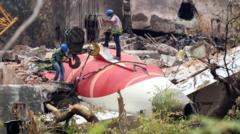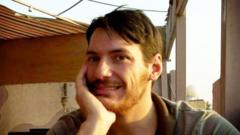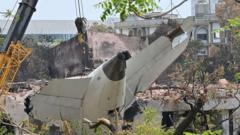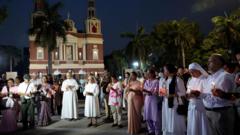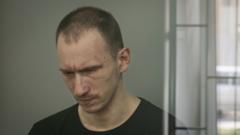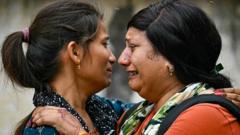The newly established Syrian Identification Centre begins the daunting task of identifying victims from mass graves linked to the ongoing civil war, with challenges including lack of resources, slow identification processes, and heart-wrenching personal stories of families left without closure.
"Revealing Stories from Syria's Mass Graves: A Long Road to Justice"

"Revealing Stories from Syria's Mass Graves: A Long Road to Justice"
Forensic experts are painstakingly identifying remains from the civil war in Syria, uncovering the painful truths behind the mass atrocities committed during the conflict.
The article text:
The newly opened Syrian Identification Centre is on a mission that will require years of diligent work. Dr. Anas al-Hourani, the facility's head, describes the contents of the centre, where dozens of human femurs rest, aligned and numbered on tables. These remnants belong to individuals from mixed mass graves — sites where victims were often piled together carelessly, telling a story of extreme violence that has claimed the lives of hundreds of thousands during the tumultuous 13 years of civil war in Syria.
Dr. al-Hourani, a forensic odontologist, understands that while a femur can reveal important information such as height and age, DNA analysis remains the gold standard for identification. Unfortunately, resources are scarce: the single DNA testing centre in Syria has been impacted by the war, and sanctions have restricted access to necessary chemicals. Additionally, at a cost of $250 per test, funding challenges postpone the identification of many more victims. Currently supported by the International Committee of the Red Cross, the lab faces overwhelming delays; identifying a single victim could take months from a mass grave.
The previous regime’s actions have left an estimated 130,000 individuals forcibly disappeared, leaving families devastated and searching for closure. The Syrian government, now in the hands of Islamist rebels, has pledged to prioritize transitional justice, yet the realities of familial searches seem disheartening to many.
Outside Damascus, BBC journalists have witnessed the mass graves themselves, which have slowly become more visible as the earth above them sinks. These graves are a stark reminder of the horrors that residents faced, as provided by testimonies from individuals such as Abu Ali, who drove military lorries transporting civilian corpses. Over several years, he witnessed the harrowing task of burying bodies under the watch of soldiers, asserting that he could discern the suffering inflicted on the deceased.
Meanwhile, individual tragedies unfold across Syria, like the story of Malak Aoude, who is tormented by the disappearance of her two sons during the regime's rule. After years as a refugee, Malak returned to Syria, holding on to the hope that her son would be found after the regime's fall, but all she has are memories. The search for answers leads her to her son's school records, revealing the last traces of Maher. Despite the fall of the Assad regime, many families remain anguished, unsure of their loved ones' fates.
As Dr. al-Hourani states, the long process of identifying victims from mass graves in Syria is only just beginning, and the road to justice is fraught with challenges and emotional burdens for the families who seek it.
The newly opened Syrian Identification Centre is on a mission that will require years of diligent work. Dr. Anas al-Hourani, the facility's head, describes the contents of the centre, where dozens of human femurs rest, aligned and numbered on tables. These remnants belong to individuals from mixed mass graves — sites where victims were often piled together carelessly, telling a story of extreme violence that has claimed the lives of hundreds of thousands during the tumultuous 13 years of civil war in Syria.
Dr. al-Hourani, a forensic odontologist, understands that while a femur can reveal important information such as height and age, DNA analysis remains the gold standard for identification. Unfortunately, resources are scarce: the single DNA testing centre in Syria has been impacted by the war, and sanctions have restricted access to necessary chemicals. Additionally, at a cost of $250 per test, funding challenges postpone the identification of many more victims. Currently supported by the International Committee of the Red Cross, the lab faces overwhelming delays; identifying a single victim could take months from a mass grave.
The previous regime’s actions have left an estimated 130,000 individuals forcibly disappeared, leaving families devastated and searching for closure. The Syrian government, now in the hands of Islamist rebels, has pledged to prioritize transitional justice, yet the realities of familial searches seem disheartening to many.
Outside Damascus, BBC journalists have witnessed the mass graves themselves, which have slowly become more visible as the earth above them sinks. These graves are a stark reminder of the horrors that residents faced, as provided by testimonies from individuals such as Abu Ali, who drove military lorries transporting civilian corpses. Over several years, he witnessed the harrowing task of burying bodies under the watch of soldiers, asserting that he could discern the suffering inflicted on the deceased.
Meanwhile, individual tragedies unfold across Syria, like the story of Malak Aoude, who is tormented by the disappearance of her two sons during the regime's rule. After years as a refugee, Malak returned to Syria, holding on to the hope that her son would be found after the regime's fall, but all she has are memories. The search for answers leads her to her son's school records, revealing the last traces of Maher. Despite the fall of the Assad regime, many families remain anguished, unsure of their loved ones' fates.
As Dr. al-Hourani states, the long process of identifying victims from mass graves in Syria is only just beginning, and the road to justice is fraught with challenges and emotional burdens for the families who seek it.

